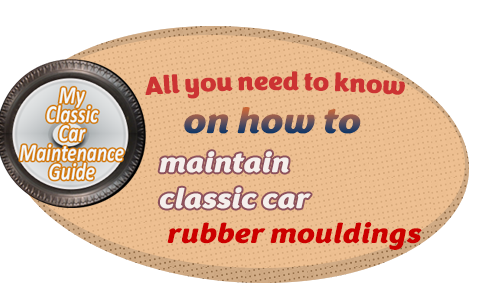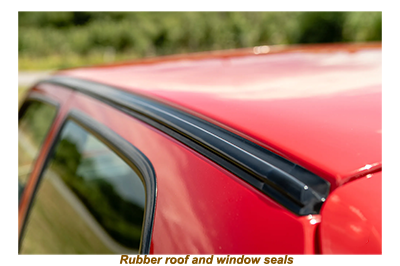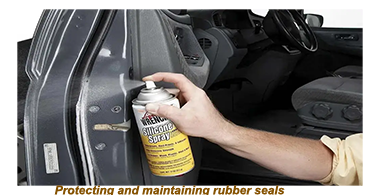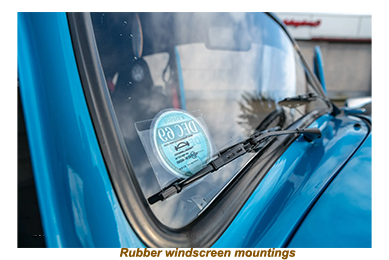
In order to protect against the elements, reduce noise, and improve the overall appearance of the vehicle, rubber mouldings are crucial in classic vehicles.
Here are some guidelines for maintaining the rubber mouldings in a classic car in excellent shape:Mouldings made of rubber are exposed to dirt, grime, and other pollutants. To maintain them clean and free of debris, you must regularly wash them with mild soap and water. Use a soft-bristled brush to clear the mouldings instead of abrasive cleaners, which can damage the rubber.
 On rubber mouldings, stay away from using abrasive chemicals like brake cleaner, acetone, or bleach. These substances may result in rubber drying out, cracking, and losing its flexibility.
On rubber mouldings, stay away from using abrasive chemicals like brake cleaner, acetone, or bleach. These substances may result in rubber drying out, cracking, and losing its flexibility.
Apply a rubber protectant: Rubber mouldings can be shielded from UV radiation and prevented from drying out and cracking by using a rubber protectant. Avoid using silicone-based products, which can create a greasy film, and use a protectant designed specifically for rubber.
 To prevent further deterioration and damage, repair the mouldings as soon as you notice any damage.
To prevent further deterioration and damage, repair the mouldings as soon as you notice any damage.
Properly store the vehicle: If you plan to retain the vintage vehicle for an extended period of time, keep it in a dry, cool environment. Extreme temperatures should be avoided because they can lead to the cracking and drying out of rubber mouldings.
By adhering to these recommendations, you can help maintain the rubber mouldings in your classic vehicle and keep them looking and performing at their best.
 Rain, weather, and dirt are kept out by rubber mouldings and seals that surround the car's windows, doors, lights, hood, trunk, and bumpers. These rubber parts serve as ornaments and enhance the vehicle's look. Rubber seals will eventually fracture or break if they are not maintained because they will become rigid and brittle.
Rain, weather, and dirt are kept out by rubber mouldings and seals that surround the car's windows, doors, lights, hood, trunk, and bumpers. These rubber parts serve as ornaments and enhance the vehicle's look. Rubber seals will eventually fracture or break if they are not maintained because they will become rigid and brittle.
 Twice a year, wash the rubber seals on the doors, trunk, and hood with detergent and water. Apply a water-based vinyl and rubber dressing to the seals. Prior to drying the seals with a clean towel, give the dressing 10 to 15 minutes to penetrate the seals, while taking whatever time necessary to ensure that the seals have fully dried to prevent cracking.
Twice a year, wash the rubber seals on the doors, trunk, and hood with detergent and water. Apply a water-based vinyl and rubber dressing to the seals. Prior to drying the seals with a clean towel, give the dressing 10 to 15 minutes to penetrate the seals, while taking whatever time necessary to ensure that the seals have fully dried to prevent cracking.
A number of prestige car manufacturers make the sublime suggestion of using talcum powder to lubricate the door and hood seals, claiming that the seal will live longer as a result. After putting the rubber and vinyl dressing, simply sprinkle talcum powder onto a small piece of T-shirt material and brush it onto the seal.
Using a brush and some soapy water, rubber seals around windows, lights, doorknobs, and mirrors should also be polished twice a year. These "exposed" rubber seals need to be repaired more frequently than door and hood seals because of the sun's powerful UV radiation.
Car doors and windows have been fitted with barriers that should prevent water from entering your car. Due to regular wear and tear, as well as the effects of weather and climate, these seals will progressively deteriorate over time.
 If the car has been fitted with a sunroof, the first port of call in any maintenance roster is the check the state of health of its seals. Classic car interiors lovingly restored and carefully preserved will suffer cataclysmic damage our interior and you as a driver could suffer greatly from a badly sealed sunroof.
If the car has been fitted with a sunroof, the first port of call in any maintenance roster is the check the state of health of its seals. Classic car interiors lovingly restored and carefully preserved will suffer cataclysmic damage our interior and you as a driver could suffer greatly from a badly sealed sunroof.
 To ensure there is nothing structurally or mechanically wrong with your car, take it to a mechanic as soon as you notice a leak that does not appear to be emanating from the windscreen.
To ensure there is nothing structurally or mechanically wrong with your car, take it to a mechanic as soon as you notice a leak that does not appear to be emanating from the windscreen.
As part of a regular maintenance program, rubber and vinyl protector should be applied to window seals once per month and door and sun roof seals every three months.
For the windscreen, the preservative should be applied before washing the glass. Before buffing it dry, apply a generous quantity and wait for it to absorb. Use a cotton or foam swab to distribute the dressing when working in small areas.
Back to the homepage- and don't spare the horsepower.
et4




